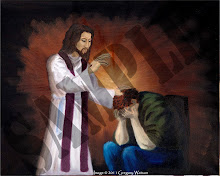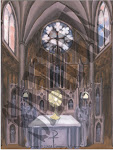The Christian Approach to ArtThroughout the centuries, the understanding of the role of art in faith, and even its goodness, has varied. As we saw earlier, art seems to have been used primarily as a form of religious expression and worship. The transcendental quality of beauty and the overwhelming power of art has led to idolatry. When God rescued the Hebrew slaves from Egypt, and gave them the Ten Commandments, He very clearly forbade this idolatry, commanding that images were not to be made and worshipped (Exodus 20:4-6). The proscription against images was not absolute, however—only the worship of them was. God Himself, after all, commanded the design and ornamentation of the furnishing of the Tabernacle—including designs on the veil separating the Holy of Holies, as well as ornamenting the Ark of the Covenant, which would be condemned by an absolute proscription against images of any kind (Exodus 25ff.). He even filled the artisans, such as Bezalel, with His Holy Spirit for the carrying out of the task (Exodus 31:1-6). Moreover, He commanded the making of a bronze serpent mounted on a pole in order to save the Israelites from the punishment of snakes (Numbers 21). It was only centuries later, when that same bronze serpent began to be worshipped as an idol itself that it was destroyed (2 Kings 18:4). Despite the nuance between permission to make images and the prohibition against worshipping them, the Israelite culture did not develop much with regard to the visual arts, becoming a much more literary culture.
Iconodulia or Iconoclasm?
With the advent of Christianity, it seems that the taboo of images was let go, as the propensity of early Christian statues and images discovered in archaeological sites demonstrates (Fortescue, 1910). Since Christ is the image of the invisible God, it seems that the Christians felt that He could in fact now be portrayed (Colossians 1:15; Galatians 3:1). Icons developed as a way of honouring Christ, Mary, and the Saints, as well as fostering devotion and educating the people. These images were venerated, and miracles were often attributed to their use. Worry about breaking the First Commandment mounted until in the 8th century and influenced in no small part by Islam, the Iconoclasts tried to abolish sacred art, believing in an overly strict interpretation of the First Commandment's condemnation of image-making and idolatry (Fortescue, 1910). However, this position was condemned by the Second Council of Nicaea, and while the iconoclast persecution continued for about a hundred more years, eventually the true use and veneration of images won out, with only patches of iconoclastic sentiment, primarily in Germanic areas (Fortescue, 1910). It was at the Reformation that iconoclasm would rear its ugly head once more in the 16th century, as idolatry would once more be levelled as a criticism against the Church. Ever since, the Catholic Church has continued to use sacred images in worship as always, and indeed has been an enduring patron of artistic expression, while Protestants have had a love-hate relationship with imagery and art (Morgan, n.d.).
Fear of Imagination and the "Safe" Christian Sub-Culture
This ambivalence towards art stems in many ways from a fear of the imagination. Because of its unpredictable and intuitive nature, it is difficult to rein in the imagination with propositional truths. This fear of the imagination within the Protestant world, especially in North America, has led to the creation of a Christian sub-culture, wherein the larger culture is imitated (Christian rock and roll, Christian romance novels, etc.) but no significant impact on the culture at large is being made. There is a reason why, despite equal or superior levels of technical skill, "Christian" art and "Christian" music is always seen as inferior to its secular counterparts; and that is its very lack of imagination, its desire to be "safe" (Wolfe, 2011, pp. 24-25). There seem to be only two uses for art in contemporary evangelicalism: to cordon oneself off from the secular world (while still enjoying aspects of the secular culture, guilt-free), or to attempt to evangelise. Like the moderns who placed art at the service of beauty for the sake of pleasure alone, the Christian sub-culture mentality places art at the service of the Gospel, reducing it to merely a tool. About this tendency, Gregory Wolfe (2011) writes:
If art is dominated by a moralistic desire to preach at the audience, it will become lifeless and didactic. We can easily spot didacticism when its message is different from what we believe, but no one who cares about art should confuse it with politics or theology. Art does not work through propositions, but through the indirect, "between the lines" means used by the imagination. (p. 24)
Christian Humanism and the Doctrine of the IncarnationWhat, then, is the Christian approach to art? Christian humanism. We must embrace art for art's sake, precisely because the act of so doing will make us more fully human. Art is incarnational; it is, or can be, redemptive. Rather than trying to withdraw from contemporary culture, or to "baptise" elements, Christian artists need to participate in the culture, and discerningly see it in the light of the Gospel. If art is about being human, we need to know what it is to be human, and to express that truthfully portraying the condition of the world, and showing how grace can penetrate into and speak to those conditions (Wolfe, 2011).
Jesus Christ, in becoming a human, united the divine with the material, the infinite and the temporal. He elevated the physical and made it capable of conveying grace. This is what the Incarnation is about; it is what sacramentality is about. Christian art participates in this sacramental and incarnational worldview because it is the uniting of form and content. In art, the medium and the message are entwined (Wolfe, 2011).
This is the real way in which Christian art evangelises—not by being consciously used as a tool for evangelism, but precisely by being art, and art that shapes culture. Fr. Barron (2013) points out that in this post-modern age, when truth is seen as relative, and good as situational, where propositions are rejected and subverted, that the beautiful, by its very nature, still speaks to hearts and imaginations. Beauty reveals to us truth and goodness, and shows us where we fall short—not propositionally, but intuitively (Scarry, 1999). Through art, we participate in that invitation to the transcendent. To a world enveloped in naturalistic and materialistic philosophy, great Christian art reminds us that there is something more, something spiritual, something transcendent, and something infinite. Like the sun through the wings of swans, Truth, Goodness, and Beauty shine through Art and invite us out of ourselves and into an intimate encounter with the Source of grace and being.
[T]here is a special quality in the essence of beauty, a special quality in the status of art: the conviction carried by a genuine work of art is absolutely indisputable and tames even the strongly opposed heart..... It is vain to affirm what the heart does not confirm. In contrast, a work of art bears within itself its own confirmation:.... Works steeped in truth and presenting it to us vividly alive will take hold of us,will attract us to themselves with great power—and no one,ever, even in a later age, will presume to negate it. And so perhaps that old trinity of Truth and Good and Beauty is not just the formal outworn formula it used to seem to us during our heady, materialistic youth. If the crests of these three trees join together, as the investigators and explorers used to affirm, and if the too obvious, too straight branches of Truth and Good are crushed or amputated and cannot reach the light—yet perhaps the whimsical, unpredictable, unexpected branches of Beauty will make their way through and soar up to that very place and in this way perform the work of all three.
And in that case it was not a slip of the tongue for Dostoevsky to say that "Beauty will save the world," but a prophecy. (Solzhenitsyn, 1970)
References for Part 3Barron, R. (2013, February 19). "To evangelize through beauty." Catholic News Agency. http://www.catholicnewsagency.com/column.php?n=2476
Fortescue, A. (1910). Iconoclasm. In The Catholic Encyclopedia. New York, NY: Robert Appleton Company. Retrieved from: http://www.newadvent.org/cathen/07620a.htm
Fortescue, A. (1910). Veneration of Images. In The Catholic Encyclopedia. New York, NY: Robert Appleton Company. Retrieved from: http://www.newadvent.org/cathen/07664a.htm
Morgan, David (n.d.). The Protestant Struggle with the Image. Retrieved from: http://www.religion-online.org/showarticle.asp?title=840
Scarry, Elaine. (1999). On Beauty and Being Just. Princeton, NJ: Princeton University Press.
Solzhenitsyn, A. (1970). Nobel lecture. In G. Wolfe (Ed.), Beauty Will Save the World (p. vi). Willmington, DE: ISI Books.
Wolfe, Gregory. (2011). Beauty Will Save the World. Wilmington, DE: ISI Books.






